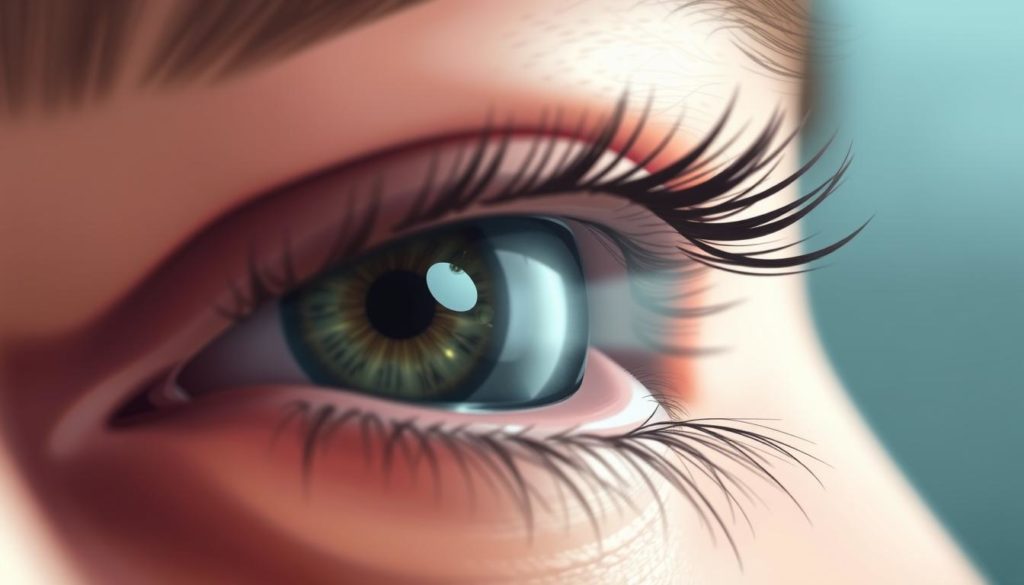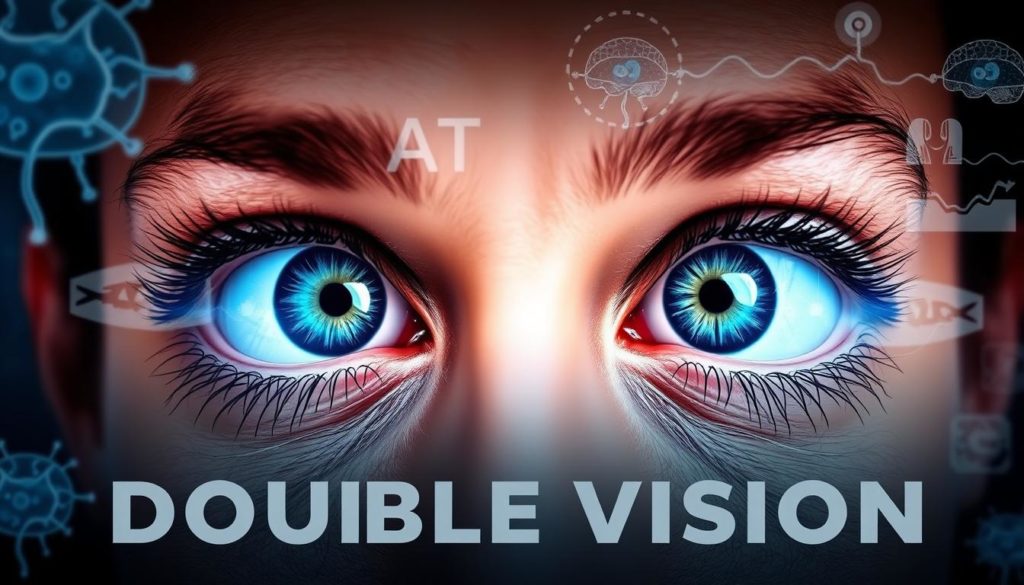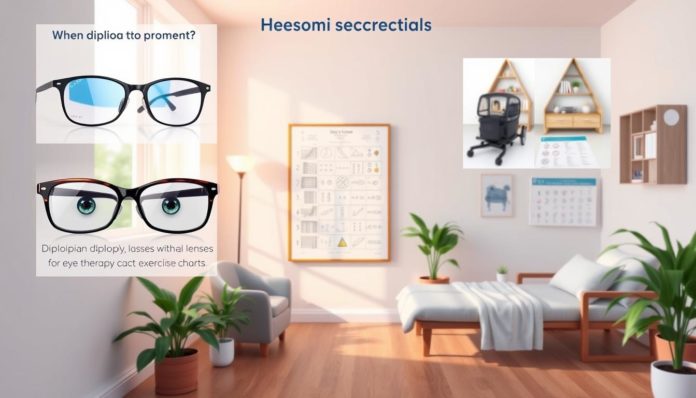Did you know that about 4.2% of people in the U.S. have Diplopia, or Double Vision? This condition can make simple tasks hard. But, many don’t know what causes it or how to fix it.
We’re going to explore Diplopia in depth. We’ll look at what causes it and find ways to solve it. If you’re dealing with Diplopia or just want to learn more, this info could change your life.
What is Diplopia?
Diplopia, or double vision, is when you see two images of one thing. It’s important to define Diplopia and know the different kinds it can be.

Definition of Diplopia
Define Diplopia as seeing two images of one thing at the same time. These images might be side by side or stacked. It can make everyday tasks hard, like reading or moving around.
Types of Diplopia
Knowing the types of double vision is key for fixing it. There are two main kinds: Binocular Diplopia and Monocular Diplopia.
- Binocular Diplopia: This happens when both eyes are open. It’s usually because the eye muscles aren’t working right. Closing one eye usually fixes it.
- Monocular Diplopia: This stays in one eye, even with the other closed. It’s often due to eye problems like cataracts or astigmatism.
Knowing the difference between Binocular Diplopia and Monocular Diplopia helps doctors find the cause and fix it.
Causes of Diplopia
Diplopia, or double vision, can be very distressing. It’s important to understand its causes for early diagnosis and treatment.
Neurological Causes
Neurological conditions are a major Double Vision causes. Brain injuries, multiple sclerosis, and strokes can mess up eye alignment. Cranial nerve palsy, which affects the nerves controlling eye muscles, also causes diplopia.
These conditions disrupt communication between the brain and eye muscles. This leads to misalignment and double vision.
Ophthalmological Causes
Eye muscle problems and structural issues in the eye also cause double vision. Strabismus and other eye muscle problems stop the eyes from aligning right. Lens dislocation or cataracts can also mess up the visual pathway, leading to diplopia.
These eye muscle problems and eye structure issues are key factors in the condition.

| Neurological Causes | Ophthalmological Causes |
|---|---|
| Brain Injuries | Strabismus |
| Stroke | Lens Dislocation |
| Cranial Nerve Palsy | Cataracts |
| Multiple Sclerosis | Corneal Irregularities |
Symptoms of Diplopia
Seeing double can be scary. Knowing how to spot *Diplopia symptoms* is important for getting the right help. It’s crucial to recognize patterns and know when to visit a doctor to protect your *vision health concerns*.
Identification and Patterns
There are a few common ways to spot *detecting double vision*:
- Horizontal double vision: Seeing two images side by side.
- Vertical double vision: Seeing two images, one above the other.
- Monocular double vision: Double vision in one eye.
- Binocular double vision: Double vision when both eyes are open, which disappears if one eye is closed.
Notice when these symptoms happen. Do they always occur, or only at certain times? Like when looking at things up close or far away? Spotting these patterns can help find the cause.
When to See a Doctor
If you notice any *diplopia symptoms*, you should get medical help. Sudden double vision, especially with pain, weakness, or other neurological signs, is an emergency. If double vision keeps coming back, it’s a sign of a bigger issue and you need to see an eye doctor.
Diagnosis of Diplopia
Getting a correct diagnosis for Diplopia starts with looking at the patient’s medical history. Then, a series of exams are done. This detailed check is key to find out why someone sees double and what treatment they need.
Medical History and Exams
First, the patient’s medical history is reviewed. This includes looking at past illnesses, surgeries, medicines, and family vision history. Next, a vision examination is done. It checks how the eyes move, if they’re aligned right, and for any vision problems.
Diagnostic Tests
To do a Diplopia assessment, several tests are used. These tests help figure out what’s causing the double vision. Some common tests include:
- Imaging tests, like MRI and CT scans, to see the brain, eye, and nearby areas clearly.
- Blood tests to find any health issues that might be causing the vision problem.
- Neurological exams to check if nerves are working right and if there are any nerve problems.
- Special eye tests like corneal topography and visual field tests to check the eye’s shape and how well you see on the sides.
Using all these tests helps doctors understand double vision better. This makes it easier to find the right treatment.
| Type of Test | Purpose |
|---|---|
| Medical History Review | Identifies past and present health issues contributing to double vision. |
| Vision Examination | Assesses eye alignment, movements, and refractive errors. |
| Imaging Tests | Creates detailed images of the brain, eye orbit, and surrounding structures. |
| Blood Tests | Detects systemic conditions influencing vision. |
| Neurological Examinations | Evaluates nerve function and identifies potential neurological disorders. |
Treatment for Diplopia
Managing Diplopia well needs knowing the different treatment options. Patients might choose non-surgical or surgical methods, depending on the cause and severity. Let’s explore these options.
Non-Surgical Treatments
Non-surgical treatments are often the first choice for Diplopia. They include Prism glasses and Vision therapy to strengthen eye muscles. Other common treatments are:
- Prescribed corrective lenses
- Specialized contact lenses
- Medication for underlying conditions
Prism glasses help align images by bending light. Vision therapy provides exercises to improve eye coordination and focus.
Surgical Treatments
For severe cases, Eye muscle surgery might be needed. This is when non-surgical methods fail. Surgical options include:
| Procedure | Description | Suitability |
|---|---|---|
| Strabismus Surgery | Adjustment of eye muscles to improve alignment | Suitable for cases causing significant misalignment |
| Botulinum Toxin Injections | Temporary weakening of overactive muscles | Used when muscle tightness affects eye movement |
Eye muscle surgery corrects muscle alignment. Botulinum toxin injections relax muscles temporarily, helping with Diplopia.
Diplopia Management Tips
Managing double vision often needs a mix of lifestyle changes and special treatments. These steps help improve daily life and quality of life for those with Diplopia.
Lifestyle Adjustments
Making lifestyle changes for Diplopia can really help. Here are some tips:
- Rest and Relaxation: Take short breaks during the day to ease eye strain.
- Optimal Lighting: Make sure your home and work areas have good, non-glare lighting.
- Healthy Habits: Eat well and exercise regularly to keep your eyes healthy.
Visual Aids and Therapy
Visual aids and occupational therapy are key in managing double vision:
- Tinted Glasses and Contact Lenses: Special lenses can help with certain types of double vision.
- Occupational Therapy: Occupational therapists create exercises to improve eye coordination and reduce double vision’s impact on daily tasks.
- Visual Rehabilitation: Visual rehabilitation programs can help you do daily activities better and on your own.
Combining lifestyle changes for Diplopia with visual rehabilitation can greatly improve managing double vision. Starting these strategies early can make life more comfortable and productive.
Exercises to Improve Diplopia
Adding specific eye exercises to your daily routine can greatly help with Diplopia. These exercises focus on strengthening eye muscles and better eye coordination. Here are some Diplopia home exercises that might help reduce double vision:
- Pencil Push-Ups: Hold a pencil at arm’s length and focus on it. Slowly move it towards your nose. Do this 10 times a day, keeping the pencil tips clear.
- Brock String: Use a string with three beads at different lengths. Hold one end at your nose and focus on each bead for clarity. This is great for eye exercises for Double Vision.
- Figure Eight: Follow a figure-eight pattern with your eyes. This exercise strengthens eye muscles and improves visual coordination.
Being consistent with these eye exercises for Double Vision is crucial. Spending a few minutes each day can lead to noticeable improvements and less Diplopia symptoms. Always talk to an eye specialist before starting any new exercise routine to make sure it’s right for you.
Consulting a Diplopia Specialist
Finding the right specialist for diplopia is key. It might seem hard, but knowing your options helps. Specialists include optometrists, ophthalmologists, and neuro-ophthalmologists. Each has their own skills and knowledge.
Finding the Right Specialist
Start by figuring out who you need. An optometrist can help with initial checks and non-surgical fixes. But, for complex cases needing surgery, an ophthalmologist is better. For issues related to the brain, a neuro-ophthalmologist is your best bet.
What to Expect During Consultation
Your specialist will look at your medical history and symptoms closely. They might suggest tests like eye exams and imaging. These help find the cause and plan your treatment.
They’ll talk about your treatment options, like glasses or surgery. They’ll also discuss the risks and benefits. This way, you can make a choice that’s right for you.
Choosing the right specialist is crucial for your treatment’s success. Do your research and pick someone who fits your needs. Whether it’s a simple check-up or complex care, the right person will help you see better.
FAQ
What are the causes of Diplopia?
Diplopia, or double vision, can come from many sources. It might be due to brain injuries, strokes, or nerve problems. It can also be caused by eye muscle issues or lens problems.
How is Diplopia diagnosed?
Doctors use several steps to diagnose Diplopia. They start with a detailed medical history and eye exams. They also do tests like imaging and blood tests to find the cause.
What are the symptoms of Diplopia?
Symptoms include seeing two images of one object. This can happen in different ways. Seeing a doctor is key to figuring out why and how to treat it.
What non-surgical treatments are available for Diplopia?
Non-surgical options include prism glasses and vision therapy. Medications can also help. These methods aim to fix eye alignment and improve vision.
When should I see a doctor for Diplopia?
You should see a doctor if you have ongoing double vision. It’s important to get checked out for serious causes. If it happens suddenly or with other symptoms, see a doctor right away.
Are there surgical treatments for Diplopia?
Yes, surgery is an option for severe cases or when other treatments don’t work. Eye muscle surgery is often used to correct misalignments.
What lifestyle adjustments can help manage Diplopia?
Making lifestyle changes can help. Using tinted glasses and improving home lighting are good starts. Occupational therapy can also help adapt to daily challenges.
Can exercises improve Diplopia?
Yes, eye exercises can strengthen muscles and help Diplopia. These exercises are part of vision therapy and can be done at home.
How do I find the right specialist for Diplopia?
Finding the right specialist is important. Look for an experienced optometrist, ophthalmologist, or neuro-ophthalmologist. Research and referrals can help find the best fit for you.
What is the difference between Binocular and Monocular Diplopia?
Binocular Diplopia happens when both eyes don’t work together. Closing one eye fixes the problem. Monocular Diplopia stays in one eye, even with the other closed. It’s often due to eye problems.


